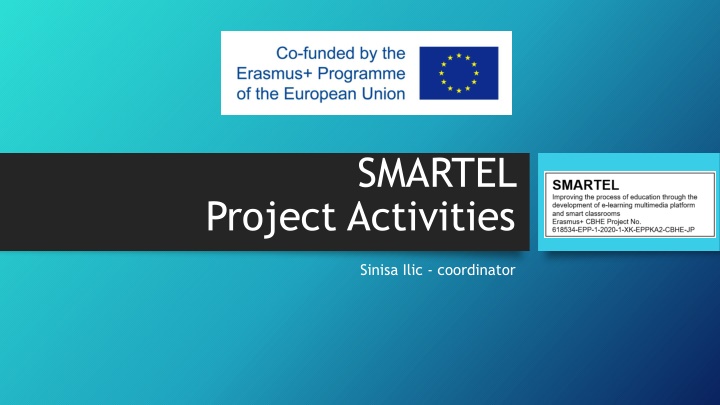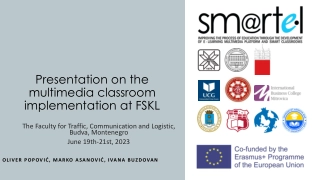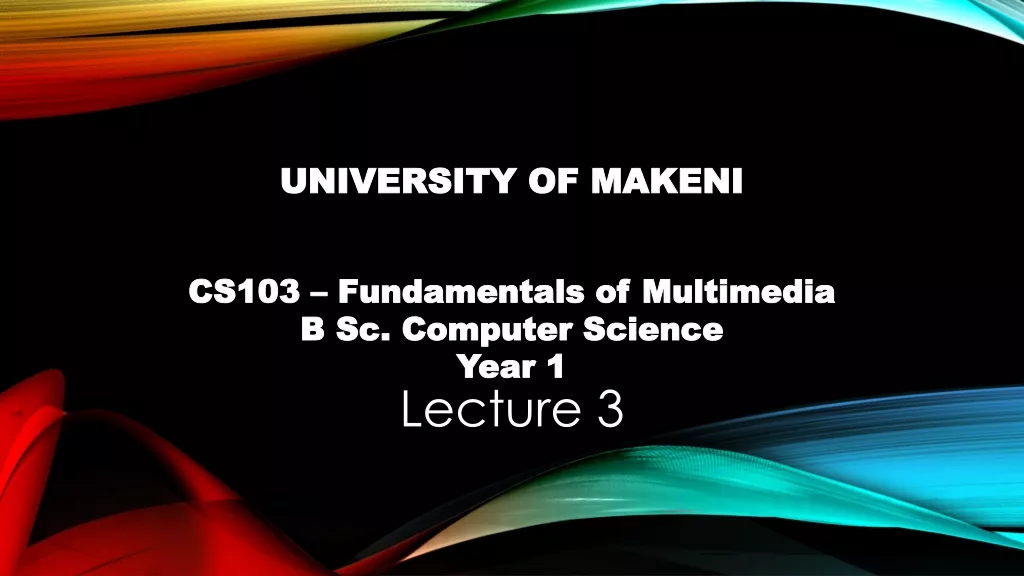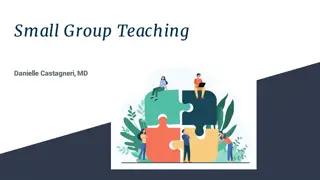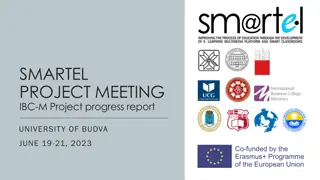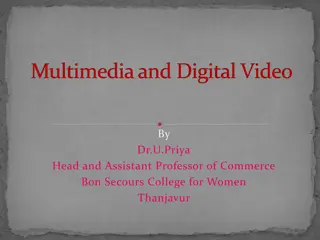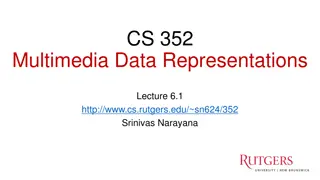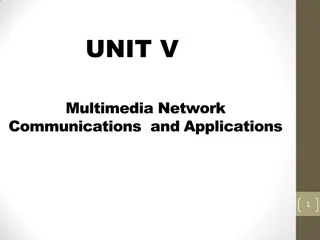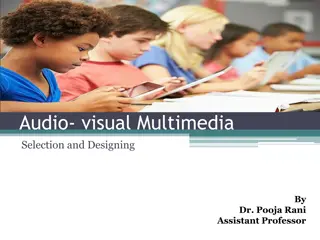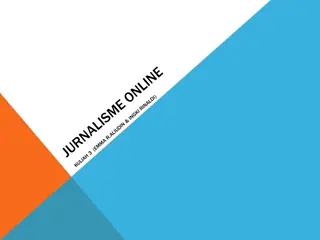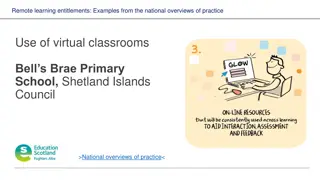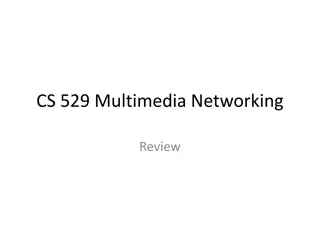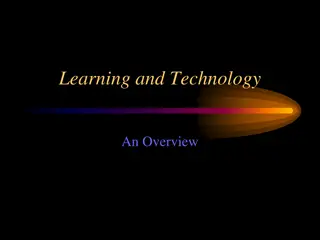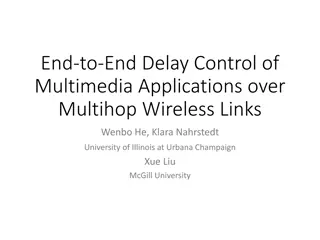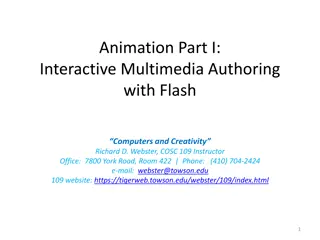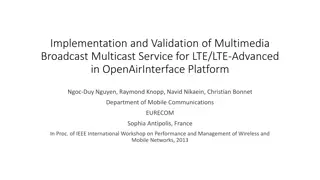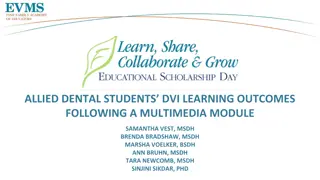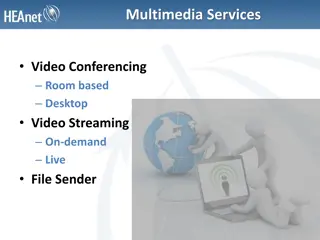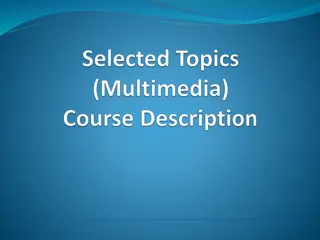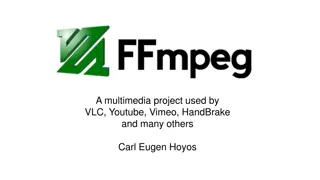Enhancing Teaching Process through Smart Classrooms and Multimedia Learning Platforms
The SMARTEL project, coordinated by Sinisa Ilic, aims to improve teaching processes at HEIs in Region 1 countries with a focus on accessibility for vulnerable student groups. Objectives include creating modern multimedia platforms, equipping smart classrooms, developing pedagogical approaches with ICT, and training staff. Smart classrooms offer interactive learning environments and adaptability for all students, including those with special needs. The project emphasizes networking among higher education institutions and the implementation of modern technologies for e-education.
Download Presentation

Please find below an Image/Link to download the presentation.
The content on the website is provided AS IS for your information and personal use only. It may not be sold, licensed, or shared on other websites without obtaining consent from the author.If you encounter any issues during the download, it is possible that the publisher has removed the file from their server.
You are allowed to download the files provided on this website for personal or commercial use, subject to the condition that they are used lawfully. All files are the property of their respective owners.
The content on the website is provided AS IS for your information and personal use only. It may not be sold, licensed, or shared on other websites without obtaining consent from the author.
E N D
Presentation Transcript
SMARTEL Project Activities Sinisa Ilic - coordinator
Aims and Objectives of the project The overall objective of the project is to improve the teaching process at the Region 1 countries HEIs with a special emphasis on enabling the accessibility of the teaching process particularly for students from vulnerable groups, for students from geographically and economically isolated areas and for other students that do not belong to the group of students with a special needs. The specific objectives of this project include: - realization of modern multimedia learning platforms, - creating e-content for multimedia platforms, - equipping the classrooms with modern ICT technology for teaching (smart classroom), - developing new pedagogical approaches based on application of ICT technologies, - training of teaching and technical staff to maintain and further develop learning platforms. Each Partner country s HEI would implement a state of the art multimedia learning platform and smart classroom. The realization of a multimedia learning platform for learning would include: -availability of teaching material in electronic form and electronic library, - video presentation of teaching and laboratory exercises, - live-streaming of significant university scientific and educational events, - integration of text, table, chart, image, sound, animation, hypertext, interactive content and complete software tools, - student participation in lecturing and lab exercises from any location and at any time, - teaching content adapted for disabled students (subtitling and speech synthesis).
Aims and Objectives of the project A smart classroom for teaching would mean: -a modern equipped classroom with modern technologies applied in e-education: smart educational environments, Internet intelligent devices, a virtual learning environment, virtual reality technologies, mobile technologies, etc., - the possibility of interactive participation of students in the realization of classes, - the ability to attend classes for students with special needs (subtitling and speech synthesis), - individual adaptation of teaching content to students, - Networking a smart classroom with other higher education institutions in the world. The hardware equipment that would be implemented in a smart classroom would include: networked computers (tablets, notebooks, ...), wired and wireless network infrastructure, projector, interactive board, airliner board, audio equipment (microphones, speakers, headphones), TV device and DVD player, cameras, VR glasses, videoconferencing equipment, etc. For all stated HEI branches (in Kosovo*, Montenegro and B&H) the broadband internet is accessible for a cheap price. The equipment in the classroom would allow streaming lectures on the multimedia platform. Each HEI would define the concept of their smart classroom in accordance with their needs and in accordance with already existing e-learning platforms. A smart classroom would be equipped with a classroom management software that allows interaction between teachers and students during teaching and student supervision by teachers. Generally, the role of a smart classroom can be divided into two.
Aims and Objectives of the project The first role is its use for teaching by using teaching methods based on modern ICT for students already located in the classroom. The second role is to provide virtual participation in the teaching process for students who are not directly in the same classroom as a teacher. Namely, students (from home or in remote unit classrooms) can use the streaming to attend the teaching, and through classroom management software can interactively participate in teaching in the same manner as students who are located in classroom with a professor. Depending on the interests of teachers and students of the HEI that uses a smart classroom, the teaching process from a single HEI can also be distributed to students belonging to a partner s HEI. These goals will be realized with the support of experts from EU partner institutions that will provide teaching and professional support in the realization of project activities. Also, the knowledge of academic staff from Partner countries HEIs will be exploited. Necessary equipment for the realization of the aforementioned goals will be procured from the budget of the project envisaged for this purpose
Working Packages Working Packages Type 1. PREPARATION 2. DEVELOPMENT 3. DEVELOPMENT 4. DEVELOPMENT 5. QUALITY PLAN 6. DISSEMINATION & EXPLOITATION 7. DISSEMINATION & EXPLOITATION 8. MANAGEMENT Working Package Name Analyses and study visits Models Design Infrastructure development Implementation and teaching process Project Quality control and monitoring Dissemination Exploitations of results Project Management
WP1 PREPARATION Analyses and study visits Deliverables + KPIs 2020 2021 11 12 1 2 3 4 5 1 Report from 4 EU institutions 1.1. Analysis of existing modern e-learning models at the Program countries HEIs. X X X 1 Report from 6 WB institutions 1 Comparative Report 1 Report from 4 study visits 1.2 Analysis of existing e-learning models at the Partner countries HEIs. X X X 1.3 Comparative analysis of the e-learning models at Program and Partner countries HEIs 1.4 Study visits to the Program country HEI (1stMadrid) X X X X X WP Leader CESIE Special attention will be paid to the applications that will help vulnerable groups (people with disability and with economic and geographical obstacles) to attend lectures in an appropriate way for them
WP2 DEVELOPMENT Models Design 2021 2022 Deliverables + KPIs 4 5 6 7 8 9 10 11 12 1 6 7 9 2.1. Defining the user requirements for modern distance learning platforms and smart labs for each partner's HEI 6 Reports - 1 from each WB institution X X X X 2.2 Defining new Innovative Pedagogical Approaches and Learning Methodologies to be implemented in teaching using modern multimedia learning platforms and smart labs 1 Report - Innovative Pedagogical Approaches and Learning Methodologies X X X X X 2.3 Developing the models of distance learning platforms and smart labs with technical specifications based on user requirements 1 Joint Report with 6 models X X X X 2.4 Organising the workshop for acceptance of proposed models (*Ljubljana) 1 Report from the event X X X 2.5 Defining the changes in syllabuses for selected courses In total 54 courses modified (9 per WB HEI) X X X 2.6 Obtaining the decision on changes in syllabuses by HEI council WP Leader University of Malta The quality of proposed models after the workshop along with the Teaching methodology developed will be verified by external expert who will evaluate that proposed solutions and methodology are feasible to be implemented, to result in achieving the project aims and goals and to be sustainable X X 6 decisions, interpreted and scanned
WP3DEVELOPMENT Infrastructure development 2021 2022 2023 Deliverables + KPIs 10 11 12 1 2 3 4 5 6 9 12 1 5 3.1 Hardware and software purchase 6 Reports - 1 from each WB institution X X X X X 3.2 Installing equipment and platform preparation X X X 1 Report with a number of components installed for each WB HEI 2.3 Modern core distance learning platforms and smart labs set-up and launching X X X 1 Report with a number of components launched 2.4 Training of administrators to maintain the distance learning platforms and smart labs (* Malta) X 1 Report from the event, 2 days, 10 training participants 2.5 Training of developers how to build interfaces between different components of distance learning platforms and smart labs and how to enhance built-in functionalities of the components (*Ljubljana) 1 Report from the event, 3 days, 12 training participants X X 1 Report, a number of enhancements and APIs implemented 2.6 Developing the interfaces and enhancing the core distance learning platform and smart labs X X X X X WP Leader University of Ljubljana The distance learning platforms and smart labs initially configured and set-up will have to be maintained, upgraded and administered by system administrators. During the life-time of the new platform the users of the system should be maintained and several profiles created: students, teachers, associates, etc.
WP4DEVELOPMENT Implementation and teaching process 2022 2023 Deliverables + KPIs 5 6 9 10 11 12 1 2 3 4 5 9 10 4.1 Training of teachers and staff to prepare content (*Malta) 1 Report 2 training days 12 participants X 4.2 Preparing the teaching content (gradually) X X X X X X X X X X X X 1 Report 180 contents 4.3 Internal training within Partner countries HEIs 1 Report 8 training sessions per institution X X X X 4.4 Organising the survey on new teaching process X X X X 1 Report on survey 4.5 Monitoring of new platform usage 6 Reports 1 per institution 18 progress tracking data exports X X X X X X X 4.6 Exchange of content between partners' HEIs X X X X X X X 1 Report 10 e-contents exchanged and used WP Leader University of Montenegro After the successful training the trained teachers will start to create the online learning material, prepare the lab exercises for smart labs, capture digital lecturing content, etc. firstly for project target groups (students with disability and economic and geographical obstacles) and then for the other students. The learning material could not be prepared in the short time frame (couple of months) but during the time gradually. Some teaching material will be prepared jointly with the partners from a business where a real case examples will be created.
WP5QUALITY PLAN Project Quality control and monitoring 2021 2022 2023 Deliverables + KPIs 1 2 3 10 12 1 3 6 9 12 6 9 10 5.1 Development of the Quality Control Plan 1 Report QCP X X X 5.2 Internal evaluation of the main project results 1 Report joint 3 annual reports X X X X X X X X X X X X X 5.3 Regular PQMC meetings X X X X X X 6 Reports MoM 5.4 External quality control of Pedagogical approaches and learning platform proposals 2 Reports 1 Pedagogical Approaches + 1 LP proposal X X 1 Report FC Report 5.5 External financial control X X WP Leader Universidad Polit cnica de Madrid In this WP it is very important to address different aspects of quality assurance in this project: Processes and activities during the project realization, and after as part of the project sustainability; Quality of outcomes; Stakeholders and user s satisfaction of developed project results; Quality of management and quality of financial management.
WP6DISSEMINATION & EXPLOITATION Dissemination 2020 2021 2022 2023 Deliverables + KPIs 11/12 1 3 10 12 1 3 6 9 12 1 9 10 6.1 Development and maintenance of the project s website 1 Website + 5 project soc.netw.channels + 5 soc.netw.posts/month X X X X X X X X X X X X X 6.2 Producing of promotional material X X X X X X X X X X X X X 1 project poster + 6 project broshures 6.3 Organisation of dissemination events X X X X X X X X X X X X X 32 dissemination events 6.4 Publishing the SMARTEL book X X X 3 publications 6.5 Organising the final project conference X X 1 Conference with 80 participants WP Leader International Business College Mitrovica Work package 6 (WP6) is focused on two types of activities: promotion of the project and its results and raising awareness of society, governmental and non-governmental bodies and other organizations about the potential benefits of the project results. Within WP6, special attention will be paid to promoting the development of new teaching pedagogical approaches, multimedia online learning platforms and their implementation on benefit to target group students with disability, economic and geographical obstacles. Visits to high schools in the country will be organised in order to promote the developed teaching methods, multimedia online learning platforms and smart labs to potential students especially in isolated areas. Promotions will be held by teachers and students. Visits to higher education institutions will be captured and displayed on the website of the project.
WP7DISSEMINATION & EXPLOITATION Exploitations of results 2020 2021 2022 2023 Deliverables + KPIs 11/12 1 3 10 12 1 3 6 9 12 1 9 10 7.1 A project sustainability plan creation 1 Report - Plan X X X X X 7.2 University-organization cooperation in Partner countries 1 Report 8 Long term Agreements signed X X X X X X X X 1 Multilateral agreement signed 7.3 Creation of a partner network of institutions X X X X X X WP Leader University of Mostar In the first year, a SC project sustainability plan will be developed. The plan will include academic and financial sustainability of the project. Academic sustainability will be achieved by establishing procedures and recommendations for permanent improvement of the developed teaching methods. Financial sustainability will be achieved through cooperation with governmental and non-governmental institutions, as well as with companies that are interested in information technology that are interested in improving the teaching process using modern ICT. In the second year of the project, the signing of a memorandum on long-term cooperation between Partner countries HEIs and business enterprises, state bodies and social associations, NGOs, and other. In the third year of the project, a partner network of institutions will be formed by the institutions participating in the project consortium and other HEIs, IT companies, institutes and other institutions. The main goal of the formed network is to exchange experiences in improving the education process using modern ICT and smart technologies. dissemination: link to social media pages, testimonies and video clips insert short info on the project on institutions websites (with the link to the project website)
WP8MANAGEMENT Project management 2020 2021 2022 2023 Deliverables + KPIs 11/12 1 4 10 12 1 5 6 9 12 6 9 10 8.1 Kick-off meeting 1 MoM X 8.2 Regular Project Management Board meetings 12 MoMs X X X X X X X X X X X X 6 MoMs 8.3 Regular Steering Committee meetings X X X X X X 8.4 Day-to-day coordination of project activities X X X X X X X X X X X X X 1 Report 8.5 Preparing the project progress report X X X 1 Report 8.6 Preparing the Final Report X X X WP Leader UPKM The major decision-making body of the project will be the Steering Committee (SC). Steering committee will consist of one of most experienced representative of each EU and Partner countries institution in management. The SC and Project Management Board (PMB) will make organisational and operative decisions. PMB will coordinate day-to-day management with local managers. In this way it will be possible to achieve appropriate balance between delegation of responsibilities and maintaining overall control of project staff performance. It is obvious that management of the project will have matrix organisational structure appropriate for the effective and efficient management. PMB will meet four times a year, while SC will meet twice a year. Between "live" meetings, online meetings will be held whenever necessary.
Indicators of progress of the wider objective Wider objective Indicators of progress: What are the key indicators related to the wider objective? How indicators will be measured: What are the sources of information on these indicators? (O1.) General objective is to provide target HEIs with innovative pedagogical methods, based on the findings of recent scientific research (Kaushik, 2016; Melero, Leo in Blat, 2012; Nicolaides, 2012), supportive technologies and knowledge needed to use them in their environments for all students, with the focus on students with special needs. (I1.) Number of different innovative pedagogical approaches introduced into each of the target HEIs; Target value (TV): at least two (2) different pilot experiments per HEI; (I1.) information from e-learning content within virtual learning environments, used for pilot experiments; (I2.) Number of trainings performed for each HEI; TV: 6 training days per participant (trainee) per HEI; (I2.) data about performed trainings, from project activities performance; (I3.) Number of students with special needs involved in the project activities; TV: 6 per HEI; (I3.) access data about students from used virtual learning applications, derived from the project;
Indicators of progress of the specific objective/s Specific Project objective/s Indicators of progress: What are the quantitative and qualitative indicators showing whether and to what extent the project s specific objectives are achieved? How indicators will be measured: What are the sources of information that exist and can be collected? What are the sources of information on these indicators? (SO1.) Increase the percentage of the lectures (or contact hours between a pedagogue and a student, or credits, or learning goals achieved) performed with the use of ICT; (I4.) Related to SO1: Increase percentage from the base value; Base value: will be defined in the project WP1; Target value(TV): 10%; (I4., I5.) base value from the management sources within target HEIs, TV will be collected from the pedagogues in target HEIs participating in the project; (SO2.) Increase the presence of students in lectures (remote or classroom) with the use of ICT; (I5.) Related to SO2: Increase percentage from the base value; Base value: will be defined in the project WP1; TV: 10%; (I6.) from the administrative sources (student offices) in target HEIs
